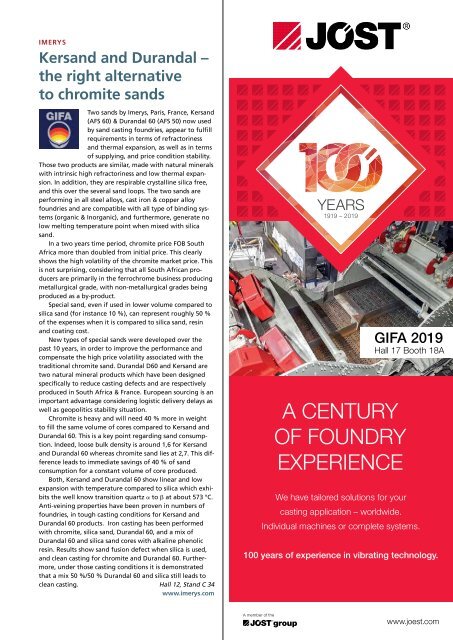CPT International 02/2019
- No tags were found...
Create successful ePaper yourself
Turn your PDF publications into a flip-book with our unique Google optimized e-Paper software.
IMERYS<br />
Kersand and Durandal –<br />
the right alternative<br />
to chromite sands<br />
Two sands by Imerys, Paris, France, Kersand<br />
(AFS 60) & Durandal 60 (AFS 50) now used<br />
by sand casting foundries, appear to fulfill<br />
requirements in terms of refractoriness<br />
and thermal expansion, as well as in terms<br />
of supplying, and price condition stability.<br />
Those two products are similar, made with natural minerals<br />
with intrinsic high refractoriness and low thermal expansion.<br />
In addition, they are respirable crystalline silica free,<br />
and this over the several sand loops. The two sands are<br />
performing in all steel alloys, cast iron & copper alloy<br />
foundries and are compatible with all type of binding systems<br />
(organic & Inorganic), and furthermore, generate no<br />
low melting temperature point when mixed with silica<br />
sand.<br />
In a two years time period, chromite price FOB South<br />
Africa more than doubled from initial price. This clearly<br />
shows the high volatility of the chromite market price. This<br />
is not surprising, considering that all South African producers<br />
are primarily in the ferrochrome business producing<br />
metallurgical grade, with non-metallurgical grades being<br />
produced as a by-product.<br />
Special sand, even if used in lower volume compared to<br />
silica sand (for instance 10 %), can represent roughly 50 %<br />
of the expenses when it is compared to silica sand, resin<br />
and coating cost.<br />
New types of special sands were developed over the<br />
past 10 years, in order to improve the performance and<br />
compensate the high price volatility associated with the<br />
traditional chromite sand. Durandal D60 and Kersand are<br />
two natural mineral products which have been designed<br />
specifically to reduce casting defects and are respectively<br />
produced in South Africa & France. European sourcing is an<br />
important advantage considering logistic delivery delays as<br />
well as geopolitics stability situation.<br />
Chromite is heavy and will need 40 % more in weight<br />
to fill the same volume of cores compared to Kersand and<br />
Durandal 60. This is a key point regarding sand consumption.<br />
Indeed, loose bulk density is around 1,6 for Kersand<br />
and Durandal 60 whereas chromite sand lies at 2,7. This difference<br />
leads to immediate savings of 40 % of sand<br />
consumption for a constant volume of core produced.<br />
Both, Kersand and Durandal 60 show linear and low<br />
expansion with temperature compared to silica which exhibits<br />
the well know transition quartz a to b at about 573 °C.<br />
Anti-veining properties have been proven in numbers of<br />
foundries, in tough casting conditions for Kersand and<br />
Durandal 60 products. Iron casting has been performed<br />
with chromite, silica sand, Durandal 60, and a mix of<br />
Durandal 60 and silica sand cores with alkaline phenolic<br />
resin. Results show sand fusion defect when silica is used,<br />
and clean casting for chromite and Durandal 60. Furthermore,<br />
under those casting conditions it is demonstrated<br />
that a mix 50 %/50 % Durandal 60 and silica still leads to<br />
clean casting. Hall 12, Stand C 34<br />
<br />
www.imerys.com<br />
A CENTURY<br />
OF FOUNDRY<br />
EXPERIENCE<br />
GIFA <strong>2019</strong><br />
Hall 17 Booth 18A<br />
We have tailored solutions for your<br />
casting application – worldwide.<br />
Individual machines or complete systems.<br />
100 years of experience in vibrating technology.

















